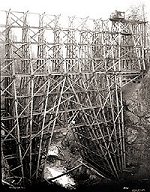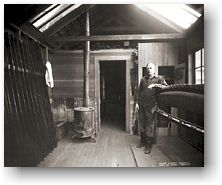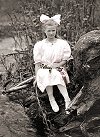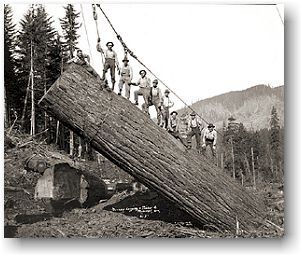Biographical Sketch of Clark Kinsey
Clark K. Kinsey was born April 15, 1877 in Grant Township, Nodaway County, Missouri.
|
|
|
Clark Kinsey in studio with photographic equipment, ca. 1899. Special Collections, UW Libraries, UW2081 |
His parents were Edmund Kinsey Sr. and Louisa McBride Kinsey. Edmund and Louisa were married February 6, 1867, in Boone County, Illinois.
Clark was the youngest of six children. Alfred was born in 1868 in Illinois. Darius — destined to be the other famous photographer in the family — was born in 1870 in Missouri. So sometime between 1868 and 1870, Edmund moved his family to Missouri. Clarence was born in 1872, Emeline (Mrs. Burt Odell) in 1873, and Edmund Jr. in 1876.
Edmund and Louisa Kinsey are believed to have purchased the first lots in the new town of Snoqualmie, Washington (later Snoqualmie Falls). They quickly became community stalwarts. The couple and their six children are widely considered Snoqualmie’s “first family.” “In the 1890s, they provided newborn Snoqualmie with a hotel, store, post office, church, meat market and community center,” reads the inscription on a plaque commemorating the Kinsey family that hangs outside the 1923 building that housed the town’s first bank. (The building was used as a city hall until a 1990 flood forced the city staff into a newer building). The Kinsey family was also responsible for building the town’s first livery stable and a hall for the Good Templars, an organization that was a strong political force in the national prohibition movement.
|
|
|
High trestle under construction, probably over Oxbow Canyon of the Wynooche River, Simpson Logging Co., n.d. Special Collections, UW Libraries, C. Kinsey 4038 |
Clark, Darius, and Clarence are said to have learned photography from a Mr. Rhinehart, who came to Snoqualmie from Chicago and stayed for one year at the Kinsey Hotel. From 1894, Clark operated studios with Darius in and north of Seattle. They would travel during the summertime from place to place in small localities throughout northwestern Washington, using a large portable tent as a studio.
“While taking pictures around Black Diamond coal mining camps in 1898, Clark met Mary Jane Williams. He was 21 and she was 16. They were married in a double wedding with Mary’s sister, Sara, and Clark’s brother Ed, in Black Diamond’s Diller Hotel.” (James, p. 29)
Around 1899, Clark and Mary went to the Klondike. Although he engaged in mining there for several years, he was most successful with his photography business. He operated a studio with his brother Clarence in Grand Forks as well as documenting in the field the many mining and engineering projects and the scenery of the Yukon Territory.
Around 1906, Clark and Mary returned to the Snoqualmie area. Clark operated a contracting firm, which he moved to Seattle in 1908. Concentrating in street and highway construction, he worked on various large projects in Seattle and King County. He eventually relocated the business to Vancouver, B.C. He also went into the chicken business in the White River valley.
|
|
|
Logging crew on cold deck, Mason County Logging Co., Bordeaux, ca. 1932. Special Collections, UW Libraries, C. Kinsey 2026 |
In 1913, however, he once again took up his camera as a professional photographer, specializing in the wood products industry, very much like his brother Darius. The two brothers were working in the same woods for a time, but they realized that this was time-wasting. So they agreed to divide up “the territory,” Clark operating mostly south of the Seattle area and Darius usually to the north.
“Clark Kinsey was a banty rooster of a man, husky for his size, 140 pounds, quick to move, agile at scrambling over logs, fearless of logging dangers and surely the most productive picture taker ever to record the deeds of men in big timber.
“A difference in the procedures of the two brothers was their processing of negatives. Darius would send his home from camps to his wife, Tabitha, who worked in a fully-equipped darkroom in their Seattle home. Clark and Mary had no home darkroom. They traveled together into the woods, lugging along three small children and enough heavy gear to sink their Tin Lizzie touring car to the axles.
|
|
|
Saw filer in shop, Preston Mill Co., ca. 1926. Special Collections, UW Libraries, C. Kinsey 2961 |
“They carried a tent and bedding as housing where camps had no extra bunkhouses. In Grays Harbor County, which had logging camps on every creek, they would rent a house in Montesano and work out of it. Clark was in the field from March to November. In summer months, the children came along with definite duties. Their first summer, Ronald, 12, took and delivered picture orders; Doris, 6, helped her mother wash prints and looked after baby Margaret, 3.
“Photography involves not only cameras but negative holders, chemicals for developing and ‘fixing’ prints, processing and washing trays, metal ferrotype plates for drying prints and heavy boxes of photographic papers. Clark worked with an 11×14-inch box camera which stood on tripod legs as high as he was. Everything was heavy and teetering.
|
|
|
Girl sitting beside a stream, ca. 1926. Special Collections, UW Libraries, C. Kinsey 2951 |
“The flivver stuffed with Kinseys and their gear was willing, but it could go only where there were roads. Many camps could be reached only by railroad tracks. Burdened like Sherpa guides, Clark and Mary and their children sometimes walked five or ten miles on bumpy ties to reach a camp.” (James, p. 29)
The Kinseys were welcomed by the loggers who would help stow their gear and built “stands” where the men could be positioned for group portraits. At times, the work was hazardous. Clark was once whiplashed by a cable at a loading site. It smashed his big camera, but the camera probably saved his bones and possibly his life. One time the entire family was working in the woods several miles from camp when a forest fire swooped down on them. “A locomotive was sent out to rescue them on flat cars. Clark, Mary and their children were told to lie flat on a car and be covered with canvas tarps which the engineer sprayed with water as he sent his lokie through smoke, flames and across a burning trestle to safety.” (James, p. 30)
His commercial success stemmed from a liberal patronage by lumber company management and by the endorsement of the West Coast Lumberman’s Association. He was able to offer almost instant service, because of the “portable” darkroom system he used. His happy customers can sometimes be seen in group photographs, holding and admiring finished prints. His corporate clients were no less pleased, as his work projected a positive and comprehensive look at commercial and technological success.
|
|
|
Logging crew yarding a very large log, West Fork Logging Co., Mineral, ca. 1935. Special Collections, UW Libraries, C. Kinsey 2 |
Clark’s career continued for more than thirty years, during which time he produced more than 10,000 images of logging camps, milling operations, equipment and crews. During World War One he documented the Spruce Division camps in Washington and Oregon. Likewise, he documented Civilian Conservation Corps camps in Washington, Oregon and California during the Depression era.
Clark’s creative life spanned a period of great technological change in the camps and a period of great social change. Much of this is reflected directly or implicitly in the large format images made with his 11 x 14-inch view camera.
Mary Kinsey died in 1933 at age 51. Clark’s zest for his work began to fade at that time. Though he remarried in 1941, his second wife, Minnie, did not become involved in photography. Both Clark and Darius Kinsey retired from active work in 1945. Clark died at age 79 at his Seattle home on November 29, 1956.
Continue to next section, “Snoqualmie Falls Lumber Company“





